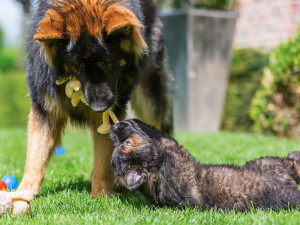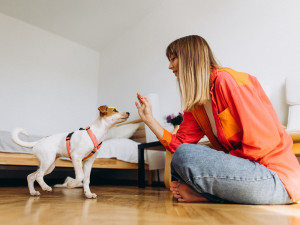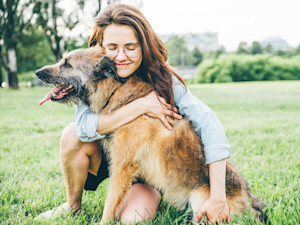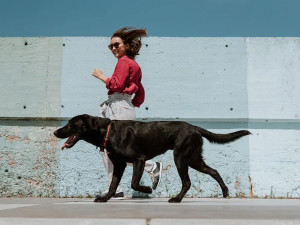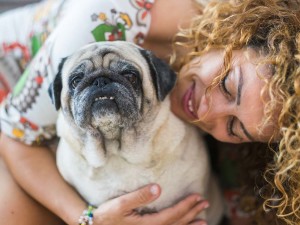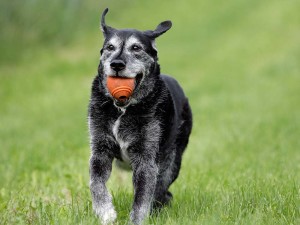Dog-Age Chart: Calculating Your Dog’s Age in Human Years
The math isn’t as cut and dry as you’d think.

Share Article
In This Article:
How To Tell A Dog’s Ageopens in a new tab How Many Dog Years Are in a Human Year?opens in a new tab How Old Is My Dog in Human Years?opens in a new tab Breed-Specific Lifespan Differencesopens in a new tab Canine Development Phases opens in a new tab Frequently Asked Questionsopens in a new tab
Don’t believe the oversimplified guidelines suggesting each dog year always equals seven human ones. Veterinarians actually calculate canine age based on weight and breed-specific developmental life stages mapped to corresponding human life stages.
Maybe your 15-year-old Chihuahua still acts like a teenager, or your two-year-old Great Dane is an old soul. But how can you know a dog’s age in human years? The old adage that every year for a dog is the equivalent of seven human years doesn’t work particularly well. Dogs go through their developmental stages much more quickly than people, so a one-year-old dog is more like a high school student than a seven-year-old.

littleKin™ is Kinship’s home just for puppy and kitten parents. Bop over to check out expert advice, new pet tools, and special deals—all curated for your newest family member.
opens in a new tabHow to tell a dog’s age
Researchers have come up with a new and potentially more accurate way to estimate how old your dog is in human years. This revised approach to determining a dog’s age is based on changes to human and dog DNA over a lifetime. This biochemical clock can be used to estimate age across species, and the researchers developed a formula based on it. This dog-age calculator still isn’t perfect, but it does a reasonable job of estimating senior dog age.
The formula says that a dog’s age in human years approximately equals 16 times the natural log (ln) of your dog’s age in years plus 31: [human age]=16*ln[dog age]+31. It’s supposed to be used for dogs over a year old but seems a little inaccurate for young adults: It estimates that a one-year dog age is the equivalent of a 31-year human age. Most people in their 30s would love to be as active and spry as a one-year-old lab, but that’s rarely the case. This formula works better for answering the question “What age is a senior dog,” because it equates a nine-year-old dog to a 66-year-old person and a 14-year-old dog to a 73-year-old.
It may be easier to think of your dog’s age in relation to life stages; these stages translate better into their human equivalents.
First year of life
Puppies mature rapidly, and it seems like they pass a new developmental milestone every few weeks. Their remarkable growth and progress in their first year mean that most dogs are fully grown by the time they’re a year old. The nitty-gritty details of their development during this period will be covered later in this article.
Second year
Some giant-breed dogs may still have some growing to do through their second year of life. Other dogs may just fill out with a little bit of muscle as they continue to mature.
Prime adult years (two to six years old)
Dogs in this age range are fully mature and at their physical peak. That doesn’t mean health issues can’t crop up, so it’s important to keep an eye out for any problems.
Senior years (around seven years old)
Dogs grow fast and they age fast, but this doesn’t necessarily mean they slow down. Some senior-dog problemsopens in a new tab can pop up sooner than you’d think, so your veterinarian may begin recommending additional care and monitoringopens in a new tab to help your dog age gracefully. Many large breed and giant breed dogs are considered to be in their senior years as early as age five.
Geriatric (around 10 years old)
Although some dogs remain active and healthy well into their teens, some may begin to show increased signs of aging as they move into their geriatric years. It’s important to keep their weight in a good rangeopens in a new tab, keep up with preventative care and monitoring, and maintain a healthy lifestyle filled with your dog’s favorite activities through this period.
How many human years are in a dog year?
The number of human years your dog ages in a single year will vary based on a number of factors. Some of the big things that affect a dog’s lifespan are their size, purebred status, and spay/neuter status. These factors affect their lifespan, which influences their relative age. Mixed breed dogs tend to live significantly longer — 1.2 years, on average — than purebred dogs of similar size.
Overall, larger dogs tend to live shorter lives, so the calculations for translating dog years into human years try to account for that. It’s impossible to consider all the factors that go into the average dog’s lifespan, so any attempts to map age correlations directly are rough estimates at best.
How old is my dog in human years?
This dog to human age chart can help give you an idea of how old your dog might be in human years. If you don’t know your dog’s age because they were added to your family after puppyhood, your veterinarian may be able to provide a possible range within a few years.
This dog age chart may seem a little confusing at first because it initially looks like small dogs age a lot more quickly than big dogs. This would seem counterintuitive because bigger dogs generally have shorter lifespans. What happens is that smaller dogs mature more quickly (reaching the equivalent of human maturity more quickly), but then age more slowly after due to their long lives. Giant-breed dogs don’t reach full maturity until they are older, so they stay “young” in human years longer. Unfortunately, they age much more quickly due to their size, so they catch up to and surpass small dogs quickly after reaching maturity.
Breed-specific lifespan differences
A reviewopens in a new tab published in February 2024 combined data from over half a million dogs in the U.K. to help determine dog lifespan by breed and size. Smaller, long-nosed dogs tend to live longer lives, while larger and flat-faced dogs tend to die younger. If you’re super curious about lifespan expectations for your dog’s breed, a full list of breeds and their survival ages can be found in the article (in the third supplementopens in a new tab).
Some highlights from the list include the Lancashire Heeler, Tibetan Spaniel, and Bolognese as the three longest-lived breeds (with a median survival of 15.4, 15.2, and 14.9 years respectively). Crossbreed dogs of all sizes had a median survival of 12 years. Giant-breed dogs, like the Caucasian Shepherd Dog, Presa Canario, and Cane Corso had the shortest survival times. English and French Bulldogs had unexpectedly low survival times for their size, likely due to issues from breeding for cosmetic traitsopens in a new tab, like a flat face.
Canine development phases
Because puppies grow so quickly in the first year of their life, it’s hard to pin a human age to each milestone of their development. It’s better to think of their development in terms of both physical and mental/social development phasesopens in a new tab.
Physical developmental phases
One to two weeks old (equivalent to a newborn): Puppies begin life mostly unaware of their surroundings. Their eyes and ears are closed off, and they rely on their mother to help them pee and poop. Over the first couple of weeks their eyes and ears will open, though vision and hearing are not normal yet.
Three to four weeks old (equivalent to an infant): Puppies in this phase are continuing to develop rapidly, but they still rely on mom for everything. When they’re not eating, they’re generally sleeping (preferably snuggled warmly with their mom and littermates). Vision and hearing clarify during this stage.
Four to eight weeks old (equivalent to a toddler): Razor-sharp teeth begin popping out, and puppies begin trying them on everything. Puppies in this age range are mobile and enjoy toddling around to explore their environment.
Two to eight months old (equivalent to a school-aged child): Puppies lose their baby teeth, and adult teeth erupt to replace them. It’s in this age range that most female dogs will first go into heat. Most puppies are sexually mature by about six months of age, but this can vary a bit based on breed and size. There will be frequent vet visits throughout this time for vaccinations, deworming, and discussions about at what age your female dog should be spayed or your male dog should be neutered.
8 months to a year (equivalent to a teenager): Puppies continue to grow and fill out. Most dogs will have reached their mature size by a year, but some large and giant dogs will continue to grow, up until they’re two years old.
Mental development phases
Neonatal stage: For the first two weeks of a puppy’s life, gentle handling is key. Mom will take care of most of this if she’s around, but careful hand-raising of puppies is possible if not. Some occasional handling by humans can get puppies used to touch and make them calmer and more confident with people later in their development.
Transitional stage: From two to three weeks of age, puppies begin to experience more of their environment as their eyes and ears open and begin to take in information from their surroundings. They may begin to growl and try to play during this stage.
Socialization stage: From three weeks to about 12 to 14 weeks of age, puppies arecreating lasting impressionsopens in a new tab from their interactions with the world. It’s extra important to keep their experiences positive during this stage so that they don’t grow fearful of bad things happening. Gentle handling by a variety of people and safe introductions to other dogs and new animals can help prepare puppies to be good canine citizens.
Juvenile stage: From the end of the socialization stage until sexual maturity (usually at about six months of age), puppies will continually test their boundariesopens in a new tab, much to their parents’ frustration. Continue to reinforce positive behaviors, teach good habits, and interact with your puppy frequently through this period. All that hard work will pay off in the long term.
FAQs
How old will a one-year-old dog be?
Most one-year-old dogs would be roughly equivalent to a person graduating high school, fully grown but not 100 percent mature. Giant-breed dogs are still growing at this age, so they’re not quite as far along yet.
How long do dogs live?
Dog lifespans vary greatly based on their size, breed, and reproductive status. Most dogs are expected to live 10 to 15 years, but there are outliersopens in a new tab on either end.
Do bigger dogs live longer than small ones?
Unfortunately, bigger dogs tend to have shorter lifespans than smaller ones on average. Health problemsopens in a new tab can vary significantly by breed as well, with flat-faced dogs suffering more issues that can lead to a shortened life.
References
McMillan, Kirsten M, et al. “Longevity of Companion Dog Breeds: Those at Risk from Early Death.” Scientific Reports, vol. 14, no. 1, 1 Feb. 2024, https://doi.org/10.1038/s41598-023-50458-w.
Ofri, Ron, and Ellen Lindell. “Department H Cateogy H Peer-Reviewed Pancreatic Biopsy Developmental Stages of Puppies.” 2016.
Urfer, Silvan R., et al. “Lifespan of Companion Dogs Seen in Three Independent Primary Care Veterinary Clinics in the United States.” Canine Medicine and Genetics, vol. 7, no. 1, 16 June 2020, https://doi.org/10.1186/s40575-020-00086-8.
Wang, Tina, et al. “Quantitative Translation of Dog-To-Human Aging by Conserved Remodeling of the DNA Methylome.” Cell Systems, July 2020, https://doi.org/10.1016/j.cels.2020.06.006.
Yordy, Jennifer, et al. “Body Size, Inbreeding, and Lifespan in Domestic Dogs.” Conservation Genetics, vol. 21, no. 1, 5 Dec. 2019, pp. 137–148, https://doi.org/10.1007/s10592-019-01240-x.

Dr. Bartley Harrison, DVM
Dr. Bartley Harrison, DVM is a small animal veterinarian based in North Carolina who has practiced emergency medicine since graduating from the Texas A&M College of Veterinary Medicine. His primary interest areas include pain management, cardiology, and the treatment of shock.
He is a member of the Veterinary Emergency and Critical Care Society, American Veterinary Medical Association, and American Medical Writers Association. In addition to his clinical work, he writes pet health articles to help provide accurate information for both new and experienced pet parents. When he’s not working, he enjoys cooking, traveling, reading, and going on adventures with his dog.
Related articles
![a person hugging a senior dog]() opens in a new tab
opens in a new tabWant to Adopt a Senior Dog? Here’s Your Cheat Sheet to Achieving Your Dream
How to search foster rescues, shelters, and sanctuaries across the country to find the right snuggle buddy.
![Older dog in Loyal drug trial to extend the lives of dogs.]() opens in a new tab
opens in a new tabA New Drug Could Make Your Dog Live Longer
LOY-002 is a drug aimed at improving your pet’s quality of life—and helping them live longer.
![Curly haired blonde woman hugging her old pug dog]() opens in a new tab
opens in a new tabHow to Care For Your Older Dog
Learn how to make their senior years as comfortable as possible.
![Older dog playing with ball in a green field]() opens in a new tab
opens in a new tabDog Arthritis Treatment: How to Relieve Arthritis Pain in Dogs
Tips for treating achy joints — from medications to massages.
![Cute girl and huge black great dane face to face in front of window at morning time.]() opens in a new tab
opens in a new tabA New Drug Aims to Extend the Life Expectancy of Large Dogs
The FDA determined it has a “reasonable expectation of effectiveness.”
![Woman playing with her puppy.]() opens in a new tab
opens in a new tabCan Puppies Lose Their Teeth? Baby Teeth In Puppies
Whether you should save them for the tooth fairy is another issue entirely.

